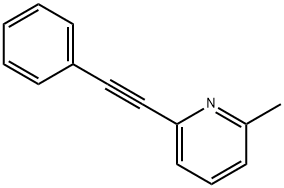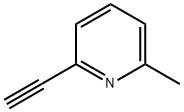MPEP
Synonym(s):6-Methyl-2-(phenylethynyl)pyridine hydrochloride;MPEP Hydrochloride - CAS 96206-92-7 - Calbiochem
- CAS NO.:96206-92-7
- Empirical Formula: C14H11N
- Molecular Weight: 193.24
- MDL number: MFCD03787983
- SAFETY DATA SHEET (SDS)
- Update Date: 2024-11-19 23:02:33

What is MPEP?
The Uses of MPEP
MPEP is a potent and highly selective non-competitive mGlu5a receptor antagonist (1,2). It is also a positive allosteric modulator at mGlu4 receptors.MPEP exhibits anxiolytic and antidepressant properties that may be applicable for treating schizophrenia (3).
The Uses of MPEP
A potent, subtype selective mGluR5 antagonist
The Uses of MPEP
2-Methyl-6-(2-phenylethynyl)pyridine induces pathophysiological mGluR5 signaling in Alzheimer''s disease model mice in sex-selective manner.
What are the applications of Application
MPEP hydrochloride is a selective antagonist of the mGluR5 receptor
Definition
ChEBI: 2-methyl-6-(phenylethynyl)pyridine is a methylpyridine that coinsists of 2-methylp[yridine bearing an additional phenylethynyl group at position 6. Potent and highly selective non-competitive antagonist at the mGlu5 receptor subtype (IC50 = 36 nM) and a positive allosteric modulator at mGlu4 receptors. Centrally active following systemic administration in vivo. Reverses mechanical hyperalgesia in the inflamed rat hind paw. It has a role as a metabotropic glutamate receptor antagonist and an anxiolytic drug. It is a member of methylpyridines and an acetylenic compound. It is a conjugate base of a 2-methyl-6-(phenylethynyl)pyridinium(1+). It derives from a hydride of an acetylene.
Biological Activity
Potent and highly selective non-competitive antagonist at the mGlu 5 receptor subtype (IC 50 = 36 nM) and a positive allosteric modulator at mGlu 4 receptors. Centrally active following systemic administration in vivo . Reverses mechanical hyperalgesia in the inflamed rat hind paw. Also available as part of the Group I mGlu Receptor Tocriset™ .
References
[1] gasparini f, lingenhöhl k, stoehr n, et al. 2-methyl-6-(phenylethynyl)-pyridine (mpep), a potent, selective and systemically active mglu5 receptor antagonist. neuropharmacology, 1999, 38(10): 1493-1503.
[2] tatarczyńska e, kłodzińska a, chojnacka-wójcik e, et al. potential anxiolytic-and antidepressant-like effects of mpep, a potent, selective and systemically active mglu5 receptor antagonist. british journal of pharmacology, 2001, 132(7): 1423-1430.
Properties of MPEP
| Melting point: | 45-45.5 °C |
| Boiling point: | 124.5-126.5 °C(Press: 0.5 Torr) |
| Density | 1.10±0.1 g/cm3(Predicted) |
| storage temp. | Desiccate at +4°C |
| solubility | Chloroform (Slightly), Methanol (Slightly) |
| form | Off-white powder. |
| pka | 2.97±0.12(Predicted) |
| color | White to Off-White |
| Stability: | Light Sensitive |
Safety information for MPEP
Computed Descriptors for MPEP
New Products
Tert-butyl bis(2-chloroethyl)carbamate (S)-3-Aminobutanenitrile hydrochloride N-Boc-D-alaninol N-BOC-D/L-ALANINOL 3-(2,4-Dimethoxybenzyl)dihydropyrimidine-2,4(1H,3H)-dione 7-Bromo-1H-indazole N-octanoyl benzotriazole 3,4-Dibenzyloxybenzaldehyde 4-Hydrazinobenzoic acid Electrolytic Iron Powder Fmoc-Val-Cit-PAB 1,1’-CARBONYLDIIMIDAZOLE R-2-BENZYLOXY PROPIONIC ACID 4-HYDROXY BENZYL ALCOHOL 1,1’-CARBONYLDI (1,2-4 TRIAZOLE) S-2-CHLORO PROPIONIC ACID (2-Hydroxyphenyl)acetonitrile 4-Bromopyrazole 5-BROMO-2CYANO PYRIDINE 5,6-Dimethoxyindanone 5-broMo-2-chloro-N-cyclopentylpyriMidin-4-aMine 1-(4-Methylphenylsulfonyl)-1H-1,2,3-benzotriazole 1-(2-Chlorobenzyl)-4-nitro-1H-pyrazole 1-(2-Nitrophenyl)-4-phenylpiperazineRelated products of tetrahydrofuran
You may like
-
 55441-95-7 2 2-BIS(2-HYDROXYETHOXY)-1 1-BINAPHTHYL 99%View Details
55441-95-7 2 2-BIS(2-HYDROXYETHOXY)-1 1-BINAPHTHYL 99%View Details
55441-95-7 -
 181228-33-1 99%View Details
181228-33-1 99%View Details
181228-33-1 -
 Ste-Glu-AEEA-AEEA-OSUView Details
Ste-Glu-AEEA-AEEA-OSUView Details
1169630-40-3 -
 1446013-08-6 Fmoc-His-Aib-OH TFA 98%View Details
1446013-08-6 Fmoc-His-Aib-OH TFA 98%View Details
1446013-08-6 -
 127464-43-1 99%View Details
127464-43-1 99%View Details
127464-43-1 -
 Chloro Uracil 99%View Details
Chloro Uracil 99%View Details
1820-81-1 -
 2-ETHYLPYRIDINE 100-71-0 99%View Details
2-ETHYLPYRIDINE 100-71-0 99%View Details
100-71-0 -
 13162-05-5 99%View Details
13162-05-5 99%View Details
13162-05-5
![3-[(2-METHYL-1,3-THIAZOL-4-YL)ETHYNYL]PYRIDINE](https://img.chemicalbook.in/StructureFile/ChemBookStructure21/GIF/CB2842239.gif)

